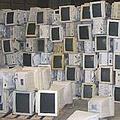 美國國會調查機構17日發表報告指出,有毒廢棄物的法規無法阻止有毒性的二手電器產品出口至開發中國家,部分原因是因為美國環保署並沒有強制執行這項規定。
美國國會調查機構17日發表報告指出,有毒廢棄物的法規無法阻止有毒性的二手電器產品出口至開發中國家,部分原因是因為美國環保署並沒有強制執行這項規定。
這份報告是由眾議院外交委員會所委託完成,國會總審計局(GAO)表示,除了環保署執法無力之外,法規本身的範疇也不足以解決這個問題。
法規目前只有規定處理一種電子產品-老式的陰極射線管(CRT)螢幕,CRT螢幕是一種特別有害的產品,因為包含高達四磅的鉛,鉛是一種已知的毒物。
但是其他種類電子產品的外銷幾乎沒有限制,即使是外銷到那些無法提供安全回收過程的國家,甚至因而造成健康和環境問題。這份報告指出,這樣的情形之所以會發生,是因為現有的有毒廢棄物法規只評估產品在美國境內垃圾掩埋場的變化情形。
而當越來越多的美國人回收舊電腦,而越來越多公司也採取了回收的作業,「開發中國家將會面臨一場相當於海嘯規模的CRT螢幕入境,毒化他們的土地和飲水。」巴塞爾非營利行動網路的普卡特(Jim Puckett)表示,他是第一位於2001年揭發大量電腦進入中國的人。
「數以千計的勞工、農工每天拆解、熔解、加熱我們的舊電腦來賺得一天一美元的收入。」普卡特17日對記者如此表示。他還說某些由廢棄電腦上所取得的鉛,又隨著玩具和珠寶的進口回到美國本土。
普卡特說,我們需要聯邦的法律,因為現有拼拼湊湊的州立法律和法規並不有效,而憲法規定不能規範貿易,「他們必須徹底地解決這一點爭議,現在他們只是把這個爭議推到黑洞裡去而已。」
一般電腦的壽命大約是兩年,美國人每年丟棄至少5000萬台的電腦,換算成一天約是3000噸,而還有上百萬台報廢電腦是留在家裡或是倉庫等待丟棄,每一台電腦都還有像是鉛、鎘、和水銀等有毒物質,如果沒有妥善處理將會危害健康和環境。
在2007年月,美國環保署開始規範CRT螢幕的出口,規定公司在出口之前需要先知會政府。
但是公司可以很簡單地歸避此法律,政府稽核辦公室發現他們可以假裝為來自香港、印度、巴基斯坦等其他國家的外國買家,來買CRT螢幕。
他們也發現有43家美國公司表達想要出口此項產品的意願。
近來由聯合國所做的調查發現,許多出口至亞洲的二手電器都在不安全的環境下進行分解,如在開放空間焚化以及為提取銅或金等金屬進行的酸化處理。
U.S. hazardous waste regulations have not stopped exports of toxic used electronics to developing countries, partly because they are not being enforced by the U.S. Environmental Protection Agency, finds a new report issued Wednesday by the investigative branch of Congress.
In the report commissioned by the House Committee on Foreign Affairs, the Government Accountability Office says that in addition to the EPA's poor enforcement performance, the regulations themselves are too limited to deal with the problem.
The rules address only one type of electronics - the old-fashioned rectangular type of monitors called cathode ray tubes. CRTs are particularly harmful because they can contain as much as four pounds of lead, a known toxin.
But exports of other used electronics flow virtually unrestricted, even to countries where unsafe recycling practices can cause health and environmental problems. This happens, the GAO reports, because the existing hazardous waste regulations assess only how products will react in unlined U.S. landfills.
While more Americans are recycling old computers and more companies are taking them back for recycling, there is a "tsunami of CRTs coming that will end up in developing countries contaminating their land and waters," said Jim Puckett of the nonprofit Basel Action Network, who first documented computer breaking in China in 2001.
"Thousands of laborers, former farmers were making $1 a day smashing, melting, cooking our old computers," Puckett told reporters on a teleconference call about the GAO report on Wednesday.
He says that some of the lead recovered from these scrapped computers is returned to the United States in the form of toys and jewelry that can poison kids.
Federal legislation is needed, said Puckett, because the current patchwork of state laws and regulations is not effective, and under the Constitution states cannot regulate foreign trade. "They must punt on that and now they're punting into a black hole," he told reporters.
The average useful life of a computer is about two years. Americans dispose of at least 50 million computers a year or 3,000 tons each day, and millions more are stored in homes and corporate warehouses awaiting disposal. Each computer contains toxics such as lead, cadmium and mercury, which if disposed of improperly can harm people and the environment.
In January 2007, the EPA began regulating the export of CRTs under a rule that requires companies to notify the agency before exporting CRTs.
But companies easily circumvent this rule, GAO investigators found when they posed as foreign buyers of broken CRTs in Hong Kong, India and Pakistan, among other countries.
They identified 43 U.S. companies that expressed willingness to export these items.
Recent surveys made on behalf of the United Nations found that used electronics exported from the United States to many Asian countries are dismantled under unsafe conditions, using methods like open-air incineration and acid baths to extract metals such as copper and gold.
全文及圖片詳見:ENS


